Since International Museum Day 2024 is themed on“Museums for Education and Research,” the Palace Museum organized four projects centered around science popularization and inheritance of traditional culture, and sharing and co-creation of museum-school cooperation resources,a testament to the museum’s achievements and measures in academic research and public education, as well as its practice and effects in educational communication and promoting the development of academic research among museums.
Wonderful World in Chinese Characters: Museum-School CooperationArtAchievements Exhibition
Chinese characters, which record and sustain Chinese culture, are the cultural genes of Chinese civilization. As the largest ancient art museum in China, the Palace Museum possesses a massive collection of ancient Chinese texts. Thanks to its research team’s years of effort, a number of achievementsin thecollection and researchofancient Chinese textual relics have been published, and the Palace Museumremainscommitted to the transformation and innovative application of the latest research achievements. On May 18, the“Wonderful World in Chinese Characters: Museum-School Cooperation Art Achievements Exhibition” was held in the Palace Museum Education Center, displayingrecent outcomes concerning ancient Chinese characters through museum-school cooperation.
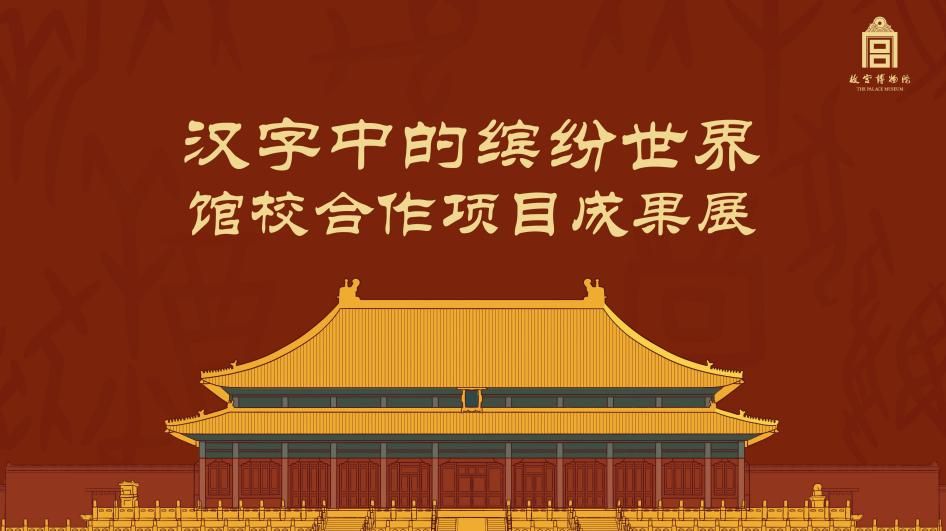
Poster for the“Wonderful World in Chinese Characters” exhibition.
The museum-school cooperation project—jointly launched by the Palace Museum, the Innovation Platform for Art-Related Subjects during the 14th Five-Year Plan of Beijing Institute of Education, andBeijing Student Jinfan Calligraphy and Painting Institute—kicked off in March 2024. The project includes a series of education activities, providing lectures, articles and display boards on science popularization for teachers,thedesign andrelease of a learning list for ancient scriptsfeaturingfunactivitiesfor teachers and students,that exploredthe artistic creation techniquesof ancient characters.

A lecture onancient Chinesecharacters for teachers.
On the morning of May 18, leaders including Zhu Hongwen, deputy director of the Palace Museum; Wu Wei, executive deputy director of the secretariat office of Beijing Student Jinfan Calligraphy and Painting Institute; Wang Su, head of the Palace Museum branch of the collaborative research and innovation platform for“the Ancient Chinese Characters and Chinese Civilization Inheritance and Development Project;” as well as representatives of teachers and students from participating schools attended theexhibition.
In her speech, Zhu Hongwen mentioned that the project realized the transformation and innovative application ofnew research achievements. The project, amicrocosm of the Palace Museum’s dedication to education and research over the years, isone of the museum’s highlights on International Museum Day this year.
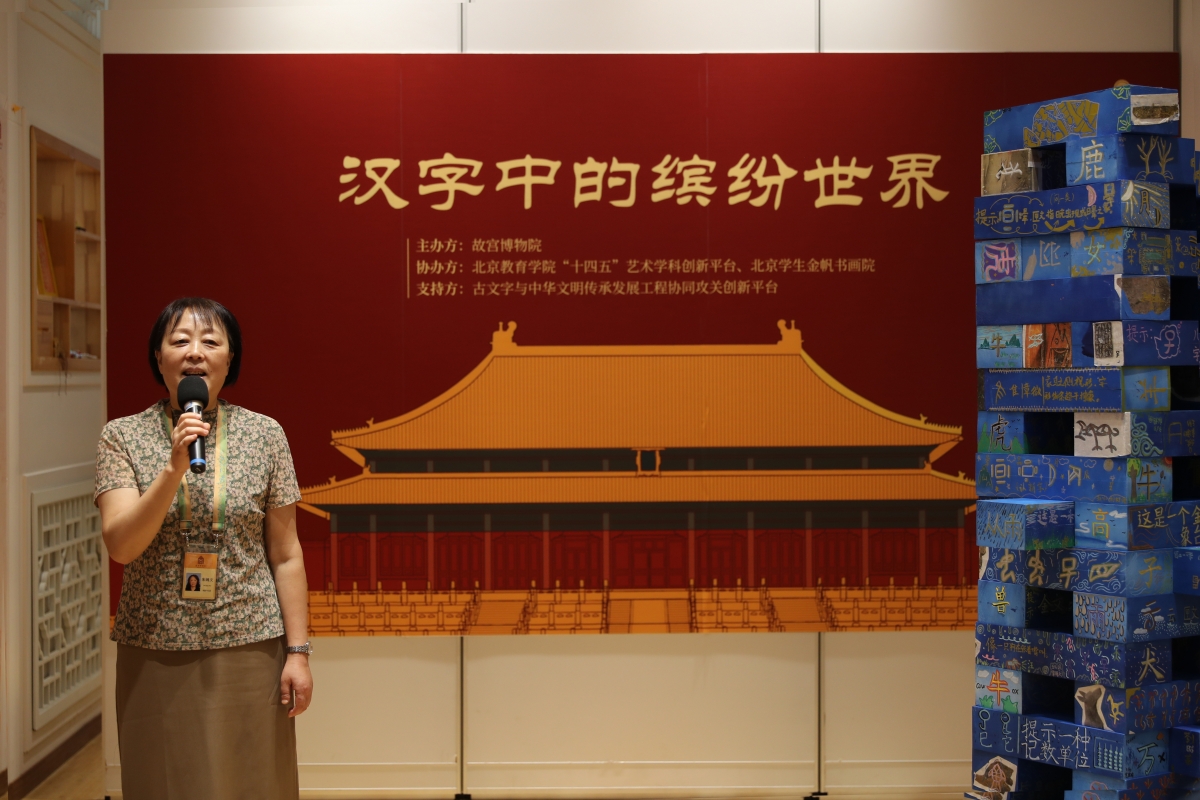
Zhu Hongwen delivers a speech.
Wang Su notedthecritical role that Chinese charactershave played in the continuous development process of Chinese civilization. He stressed the importance of students’ ability to read ancient Chinese charactersin their pursuit oflearning traditional Chinese culture, and spoke highly of how thecooperation had facilitated the transformation and dissemination of ancient Chinese characters through science popularization.
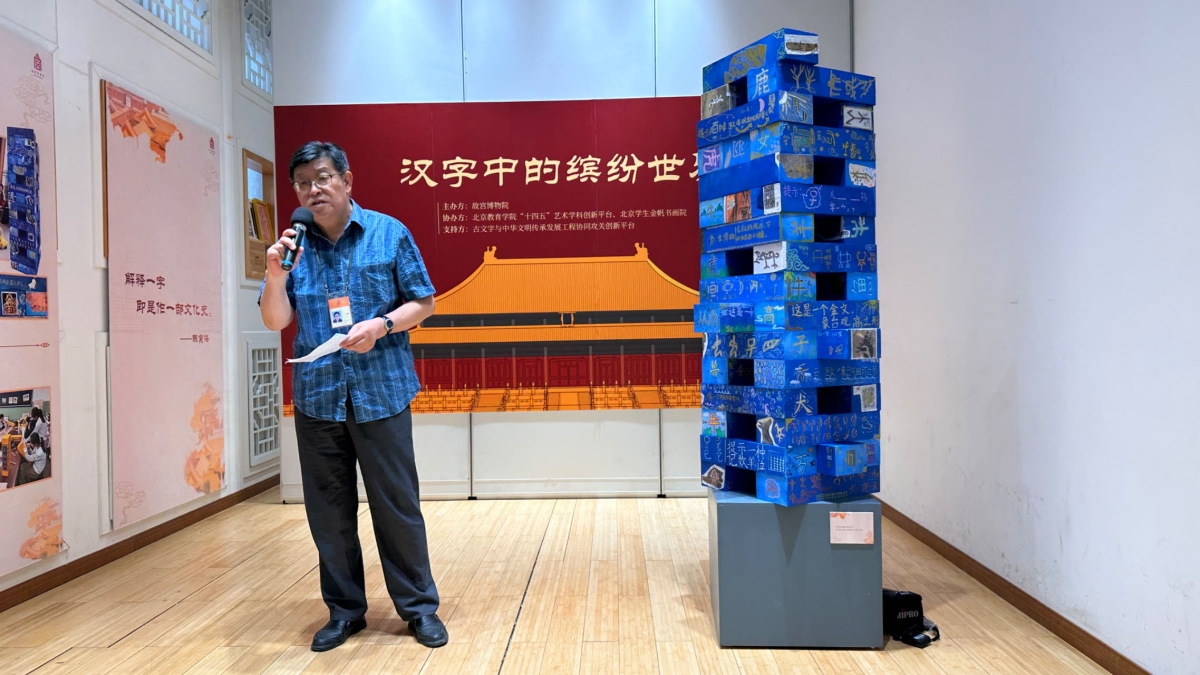
Representative from“the Inheritance and Development Project of Ancient Chinese Characters and Chinese Civilization” delivers a speech.
The“Wonderful World in Chinese Characters: Museum-School Cooperation Art Achievements Exhibition” is open to the public until this weekend. Exhibition panels based on the Palace Museum’s ancient characters collections areondisplay,as well as works created by teachers andstudents,whichillustrate not only the museum’s rich ancient script collection, but also the cognition and interpretationthrough colors and imagesby children.


Learning list and art works created by teachers and students.
“Our Forbidden City”
Educational ResourcesReleased Online
The Palace Museum releaseda number ofeducational resources on the theme of“Our Forbidden City”on the youth edition of itsofficial website, which canbe download and utilizedby teachers and students forfree.
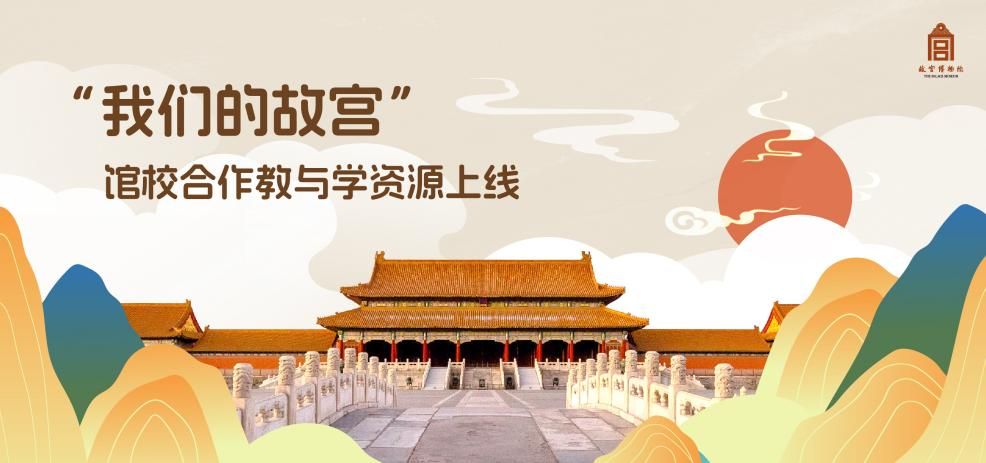
Posterpromoting the release of “Our Forbidden City” educational resources
The resources arethe result of the “Our Forbidden City” project jointly launched by the Palace Museum and the Hong KongAcademy of ChineseStudies in 2022. The project hadpreviouslylaunched a set of exhibition panels,handbooks, and photocollections for teachersin Hong Kong. As of April 2024,the resourceshad reached 252 schools and benefited more than 80,000 students. The educationalteam at the Palace Museum has renewed and revised the educational resources of the“Our Forbidden City” project to meet the needs of students in the Chinese mainland, launching 68 educational programs covering primary and secondary school students. The fruits of their labor are presentedin the forms of thematic panels and handbooks, self-study materials, and PowerPoint slides,assisting studentsin their discovery of thebeauty of the Forbidden City.
In recent years, under the guideline released by the Ministry of Education and the National Cultural Heritage Administration on the utilization of museum resources in primary and secondary school education, the Palace Museum has leveraged modern information technology to build an online museum resource platform and a museum resource library for youth education, promoting the integration of museum resources into the country’s education system. These educational resources recently released online can be usedas teachingresources and as the basis forthedesignof thematic curriculum. Teachers of different disciplines can extract the required information, combinewith their respective teaching objectives, andapplythem to a series of teaching activities.
During the process ofresources integration, the Palace Museum invitedBeijing No. 1 Kindergartenand Children’s Palace ofDongcheng District to design courses with the resources.On May 18, a demonstrative open class from thetwo institutions was heldin the Palace MuseumEducation Center. Two teachers were invited to evaluate the class on-site, including Lu Jing,teaching researcher of thepre-school training department ofthe Institute of Educational Sciences ofDongcheng District, and Huang Youfang, an inheritor of intangible cultural heritage in Dongcheng District. In addition, theopen class was alsoattended by members of the public who observed and shared educational resources.

Teachers evaluate the open class.
Short Video Series“Visiting the Palace Museum onDouyin” Season 3 Released
In the run-up to International Museum Day on May 18, the Palace Museum’s official Douyin (known as TikTok abroad) accountreleasedseason 3 of the short video series“Visiting the Palace Museum onDouyin”. The videos feature professionals from the museum elucidating on various topics, including the architecture, calligraphy and painting, literary works, weapons, jade, toys, and gold and silver wares.
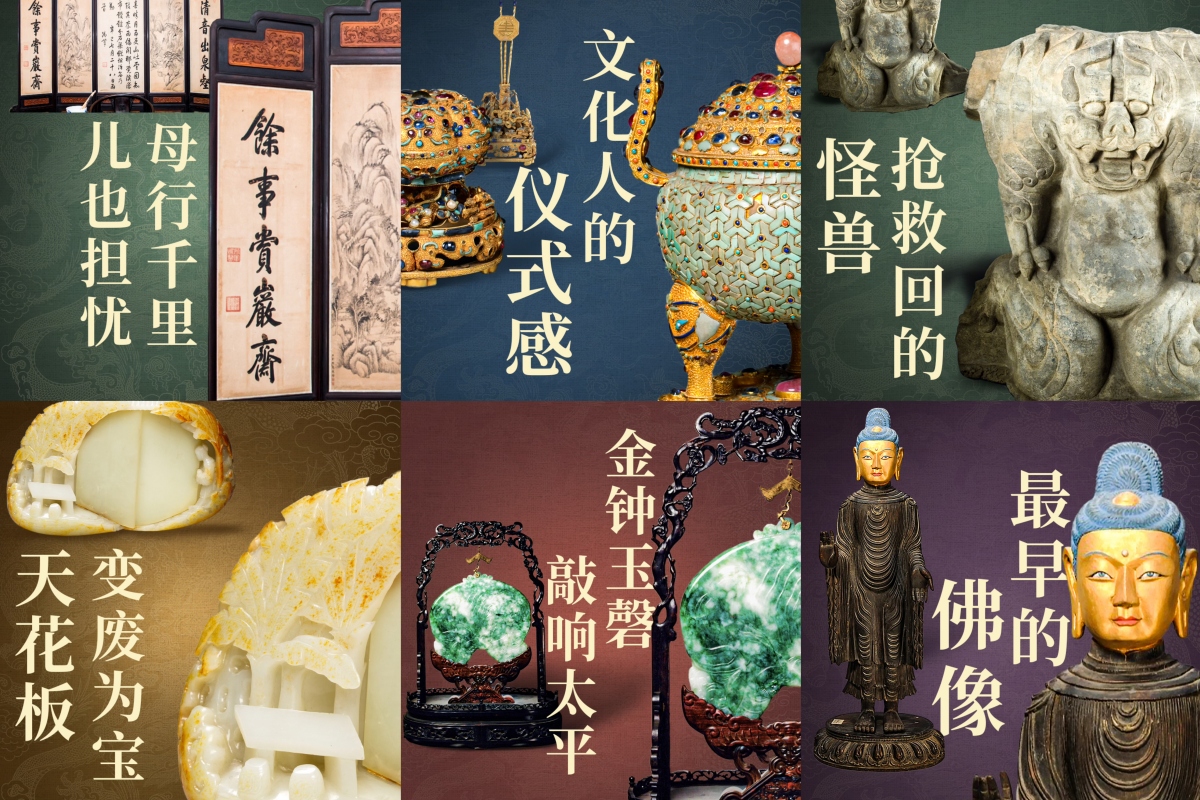
Posters forthe short video series“Visiting the Palace Museum onDouyin” (season 3).
Season 3 includes more cultural relics categories, especially thosethat visitors may have overlooked, such as the sculpture galleryin the Palace of Compassion and Tranquility (Cining Gong), the original display of the Palace of Longevity and Health (Shoukang Gong), and the special exhibitions “The Most Honorable Treatment: Empress Dowager Chongqing” and “Long Live the Emperor! Exhibition of Imperial Birthday Celebrations.” In terms ofthe way ofnarration,season 3 continues to explore the stories behind the artifacts, focusing on storytelling, entertainment value and interconnectedness,including the story of themountain-shapedcarvingjade (Yu Shan Zi), the “nesting doll”-like writingbrushes, the modified flowervases, and the screencarrying Emperor Qianlong’s poem for his mother. The presentationisthe first time thatmatting and compositingtechnology has been utilized, which enablesthe narrator to“walk into” the ancient paintings,providing the audience with an immersive experience in the world of ancient paintings.
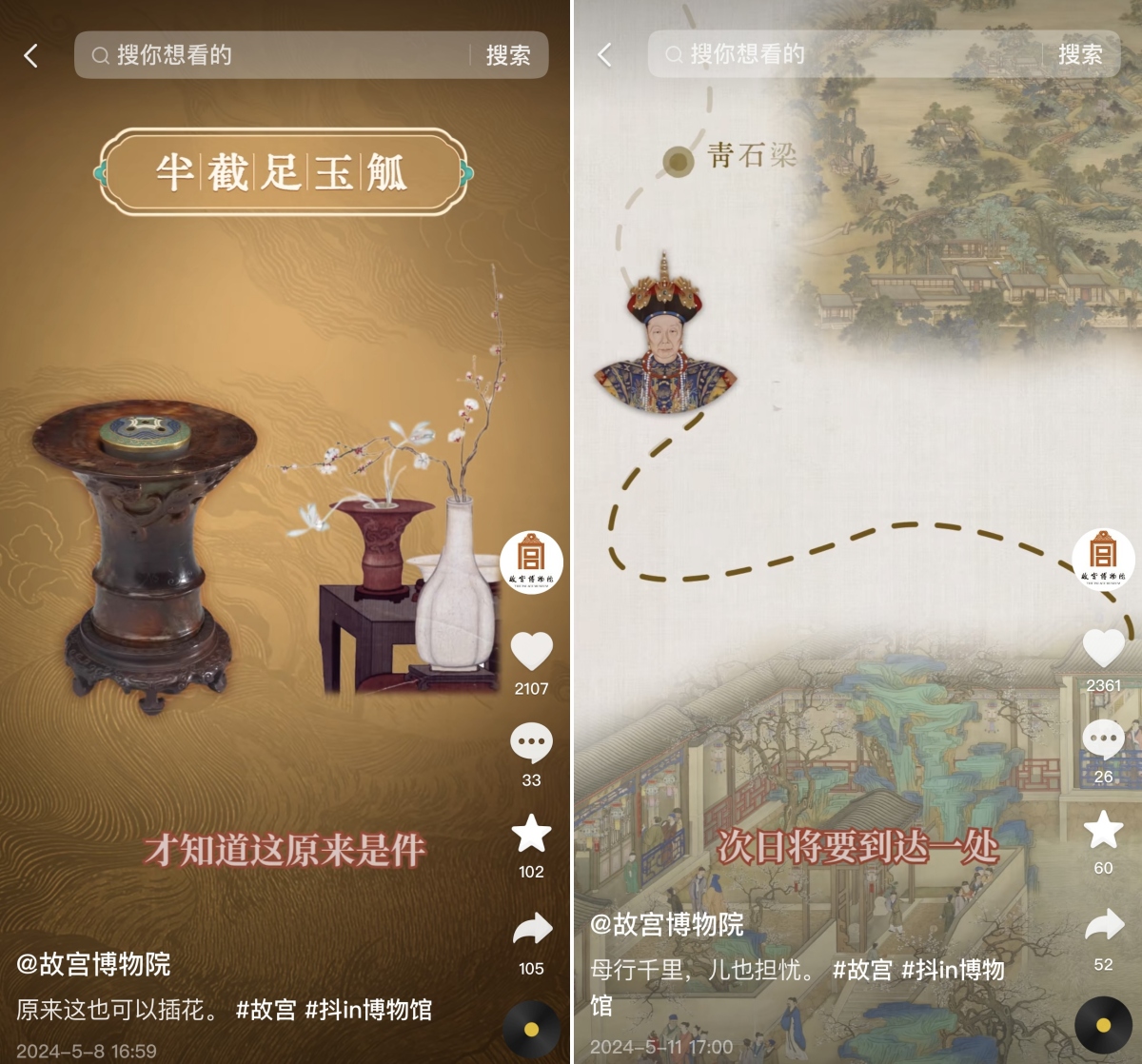
Visual effects of “Visiting the Palace Museum onDouyin”.
The Palace Museum is resolutely committed tothenotion of “bringing culturalrelicsto life,” transformingthe professional and authoritative knowledgeabout theForbidden City intothe interesting and informative videos, conveying the concepts, wisdom and emotions embedded inancient buildings and culturalrelics, andcarryingforward the core socialist values.
Palace Museum Volunteers PresentLectureson Traditional Culture
Volunteers play an important role in the publicity and education work of the Palace Museum. On May 18, the Palace Museum saw its volunteers engage in thematic publicity and visiting services. At the open routes and the entrances to the museum, volunteers providedvisitors with access to route planning, exhibition interpretation,information services. They also publicizedInternational Museum Day among the visitors.

Volunteers in service atthe Palace Museum.
On the same day, the Palace Museum sent two members of its Voluntary Culture Publicity Team to give culturallectures at Beijing Economic-Technological Development Area (also known as Beijing E-Town). The lectures, themed“TheTimers in the Palace Museum” and “DecorativePatterns on Blue-and-WhitePorcelain Wares,” helped spread the Forbidden City culture and vitalize the social life in Beijing E-Town.

Lectures at BeijingE-Town.
The Voluntary Culture Publicity Team of the Palace Museum, established in 2006, is composed of the museum volunteers.Previously, the team had delivered lecturesin Chaoyang District, Beijingin April.Three lectures were held on May 10 and 18.Looking ahead, the volunteer team will offer another thematic lecture—“Vigorous Dragons and Phoenixes: Story of the Tian-Tsui Phoenix Crown Adorned with Pearls and Gems and Filigree Dragon in the Collection of the Palace Museum”— on May 24.
The Palace Museum emphasizes the integration of culture, museum, and education. It aims to fully utilize its role in education by promoting collaboration with schools, creating educational content, and expanding its influence.In the years to come, the museumwill staycommitted to creatively transforming, interpreting, anddisseminating traditional Chinese culture, while providing visitors with a range of educational services and experiences throughtappingeducational resources andinnovating teaching methods.



